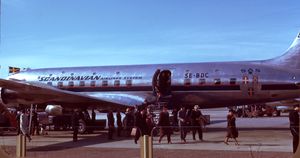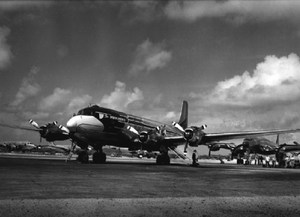PlaneSpottingWorld welcomes all new members! Please gives your ideas at the Terminal.
Douglas DC-6
| Douglas DC-6 | |
|---|---|
| Douglas DC-6 flown by the United States Weather Bureau. | |
| Type | Airliner/transport aircraft |
| Manufacturer | Douglas Aircraft Company |
| Introduced | March 1947 |
| Status | 49 fully active |
| Produced | 1946-1959 |
| Number built | >700 |
| Developed from | Douglas DC-4 |
| Variants | Douglas DC-7 |
The Douglas DC-6 is a piston-powered airliner and transport aircraft built by the Douglas Aircraft Company from 1946 to 1959. Originally intended as a military transport near the end of World War II, it was reworked after the war to compete with the Lockheed Constellation in the long-range transport market. More than 700 were built, and many still fly today in cargo, military, and wildfire control roles.
The DC-6 was known as the C-118 Liftmaster in United States Air Force service, and as the R6D in United States Navy service.
Contents
History
The United States Army Air Forces commissioned the DC-6 project as the XC-112 in 1944. The Air Force wanted an expanded, pressurized version of the popular C-54 Skymaster transport with improved engines. By the time the XC-112 flew, the war was over, and the USAAF had rescinded its requirement.
Douglas converted its prototype into a civil transport (redesignated YC-112A, having significant differences from subsequent production DC-6 aircraft) and delivered the first production DC-6 in March of 1947. However, a series of mysterious in-flight fires (including the fatal crash of United Airlines Flight 608) grounded the DC-6 fleet later that year. The cause was found to be a fuel vent located adjacent to the cabin cooling turbine intake. All DC-6's in service were modified to correct the problem, and the fleet was flying again after just four months on the ground.
Pan Am used DC-6 aircraft to inaugurate its first trans-Atlantic tourist class flights, starting in 1952.
On November 1 1955 a time bomb exploded aboard a DC-6 killing 44 people above Longmont, Colorado.
The USAF Strategic Air Command had C-118 Liftmasters in service from 1957 through 1975.
Douglas designed four basic variants of the DC-6: the "basic DC-6," and higher-gross-weight, longer range versions—the "DC-6A" had a large cargo door and was designed for cargo work, while the "DC-6B" was designed for passenger work and the "DC-6C" was a "convertible" aircraft that could accommodate both. The military version, essentially similar to the DC-6A, was the C-118. The DC-6B, powered by Pratt & Whitney R-2800-CB-17 engines with Hamilton Standard 43E60 constant speed reversing propellers, was regarded by many to be the ultimate piston-engine airliner from the standpoint of ruggedness, reliability, economical operation, and handling qualities.
The military renewed its interest in the DC-6 during the Korean War, and commissioned a number of aircraft that later found their way into civilian service. Harry Truman's first presidential aircraft was an Air Force VC-118 called The Independence.
Many older DC-6 aircraft were replaced by the Douglas DC-7: those that survived into the Jet Age were replaced by Boeing 707 and Douglas DC-8 aircraft.
Airlines
Historical operators of the DC-6 include Aerolíneas Argentinas, Air Vietnam, Alaska Airlines,Alitalia, American Airlines, Aviateca, Canadian Pacific Air Lines, Great Lakes Airlines, JAT Jugoslovenski Aero Transport (now Jat Airways), KLM, LAN Chile, Mackey Airlines, Mexicana, National Airlines, Northeast Airlines, Northwest Orient, Olympic Airways, Pan American World Airways, Mexicana, Panair do Brasil, Philippine Airlines, Sabena, SAS, TEAL, Trans American Airlines,Transocean,United Airlines, Western Airlines, and Yemen Airlines.
Today, most DC-6's in commercial use are based in Alaska. Air Cargo Express, Everts Air Fuel, and Northern Air Cargo operate the type. Several other DC-6's are still in operation for small carriers in South America. Atlantic Airlines, a cargo carrier based in Coventry, England, also uses the type.
Military Operators
- Template:ROC
- Template:COL
- Template:CUB
- Template:ESA
- Template:FRA
- Template:GER
- Template:GUA
- Template:HON
- Template:MEX
- Template:NZL: RNZAF
- Template:POR
- Template:SKO
- Template:USA: USAF, US Navy
- Template:YUG
DC-6 after 60 years
2006 marked the 60th anniversary since the introduction of the DC-6. The March issue of Airliner World had an article about the aircraft.
- About 100 still fly (or are potentially capable of flight)
- In 2002, 49 were fully active
- Two DC-6 were used as freighters by Atlantic Airlines, Coventry, UK (see website, none currently in use)
- One is in use by Red Bull in Salzburg, Austria
- One DC-6 is in use by Namibia Commercial Aviation
- An unknown number are in use as freighters or waterbombers in Canada and Alaska
Several DC-6 are preserved in museums. The most well known is President Harry S. Truman's Independence, which is preserved at Wright Patterson Air Force Base in Ohio
Specifications (DC-6B)
Data from Airliners.net[1]
General characteristics
- Crew: 3: captain, copilot, flight engineeer, plus attendants appropriate to number of passengers
- Capacity: 54-102 passengers
- Length: 105 ft 7 in (32.18 m)
- Wingspan: 117 ft 6 in (35.81 m)
- Height: 28 ft 5 in (8.66 m)
- Wing area: 1,463 ft (135.9 m)
- Empty weight: 55,357 lb (25,110 kg)
- Max takeoff weight: 107,000 lb (48,500 kg)
- Powerplant: 4× radial engine, 2,500 hp (1,700 kW) with water injection each
- Propellers: Hamilton Standard 43E60 "Hydromatic" constant speed props with autofeather and reverse thrust
Performance
- Cruise speed: 274 knots (315 mph, 507 km/h)
- Range: 2,610 nm (3,010 mi, 4,840 km)
- Service ceiling: 25,000 ft (7,600 m)
- Rate of climb: 1,070 ft/min (5.44 m/s)
References
- ↑ Lundgren, Johan (1996-2006). The Douglas DC-6. Airliners.net. AirNav Systems LLC. URL accessed on 2006-03-20.
External links
Related content
Related development
Comparable aircraft
Designation sequence
- Air Force: C-109 - C-110 - C-111 - XC-112 - C-113 - C-114 - C-115 - C-116 - C-117 - C-118 - C-119 - C-120 - C-121
- Navy: R3D - R4D - R5D - R6D
Related lists
See also
Template:Douglas Airliners
Naval Fighters: XFD · F3D · F4D · F5D · XF6D - Fighters: XP-48 · P-70 · F-6 · F-10
Naval Attack: DT · T2D · XT3D · BT · TBD · SBD · XBTD · XTB2D · AD · XA2D · A3D · A4D
Bomber: YB-7 · YB-11 · B-18 · XB-19 · XB-22 · B-23 · B-26 · XB-31 · XB-42 · XB-43 · B-66
Attack: XA-2 · A-20 · A-24 · A-26 · A-1 · A-3 · A-4
Reconnaissance: O-2 · OD · O2D · O-31 · O-35 · YO-44 · YOA-5 · PD · P2D · P3D
Transports: C-1 · C-21 · C-39 · C-47 · C-53 · C-54 · C-58 · UC-67 · C-74 · C-110 · C-118 · C-124 · C-133 · C-24
Naval Transports: RD · R2D · R3D · R4D · R5D · JD · R6D - Experimental: DWC · D-558-1 · D-558-2 · X-3
Lists relating to aviation | |
|---|---|
| General | Timeline of aviation · Aircraft · Aircraft manufacturers · Aircraft engines · Aircraft engine manufacturers · Airports · Airlines |
| Military | Air forces · Aircraft weapons · Missiles · Unmanned aerial vehicles (UAVs) · Experimental aircraft |
| Notable incidents and accidents | Military aviation · Airliners · General aviation · Famous aviation-related deaths |
| Records | Flight airspeed record · Flight distance record · Flight altitude record · Flight endurance record · Most produced aircraft |
de:Douglas DC-6 fr:Douglas DC-6 ms:Douglas DC-6 nl:Douglas DC-6 ja:DC-6 no:Douglas DC-6 sv:Douglas DC-6


